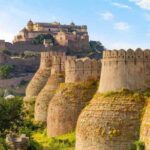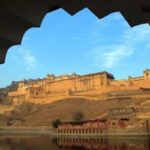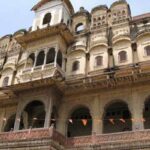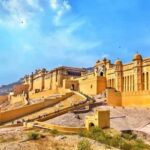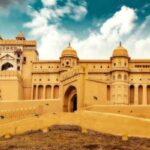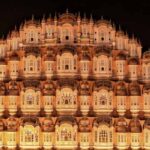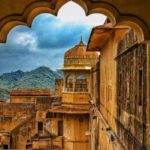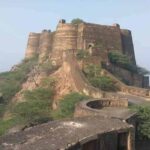13 Famous Historical Forts in Jaipur, the capital city of Rajasthan, India, boasts a rich tapestry of history, culture, and architecture, with several famous forts adorning its landscape. Among these, the Amber Fort stands out as an iconic symbol of Jaipur’s grandeur. Situated atop a hill overlooking Maota Lake, this majestic fort features stunning Rajput architecture, intricate marble carvings, and expansive courtyards. Its Sheesh Mahal (Mirror Palace) is particularly renowned for its exquisite mirror work.
Jaigarh Fort, located atop the Cheel ka Teela (Hill of Eagles), is another notable stronghold in Jaipur. Built primarily for defense purposes, it offers panoramic views of the surrounding landscape and houses the impressive Jaivana Cannon, the world’s largest cannon on wheels.
Nahargarh Fort, perched on the Aravalli Hills, completes the trio of famous forts in Jaipur. Initially constructed as a retreat for the kings, it provides breathtaking views of the Pink City and is adorned with beautiful frescoes and intricate architecture, Jaipur Tour Planner.
These forts not only serve as architectural marvels but also as poignant reminders of Jaipur’s royal heritage, offering visitors a glimpse into the city’s illustrious past and the grandeur of Rajputana architecture.
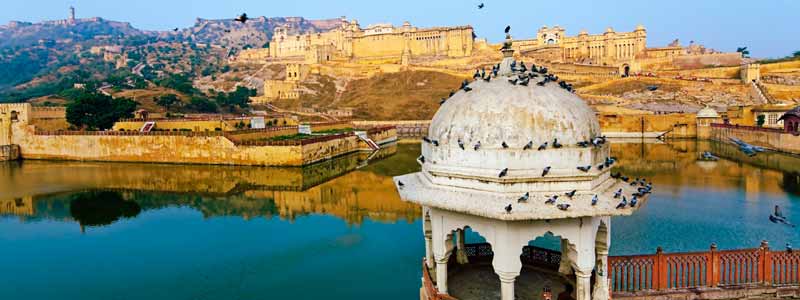
Amer Fort
Amer Fort, also known as Amber Fort, is a majestic historical fort located in Amer, a town near Jaipur, the capital of the Indian state of Rajasthan. Constructed in the 16th century by Raja Man Singh I, a trusted general in the army of Mughal Emperor Akbar, the fort exemplifies a blend of Rajput and Mughal architectural styles, Jaipur Tourism.
Perched on a hill, Amber Fort is an architectural marvel with its intricate design, artistic elements, and strategic location that offers panoramic views of the surrounding landscape. The fort is primarily built with red sandstone and marble, featuring a series of imposing gates, courtyards, and palaces.
One of the standout attractions within the fort is the Sheesh Mahal, or the Mirror Palace, adorned with intricate mirror work that reflects light in a mesmerizing manner. The Diwan-i-Khas (Hall of Private Audience), Diwan-i-Am (Hall of Public Audience), and Sukh Niwas (Hall of Pleasure) are other notable structures within the fort, showcasing the opulence and grandeur of the Rajput rulers.
Visitors to Amer Fort can ascend the hill either by walking, riding an elephant, or taking a jeep. The fort is not only a UNESCO World Heritage Site but also a popular tourist destination, attracting people with its historical significance, architectural brilliance, and the breathtaking views it offers of the surrounding Aravalli hills and Maota Lake.
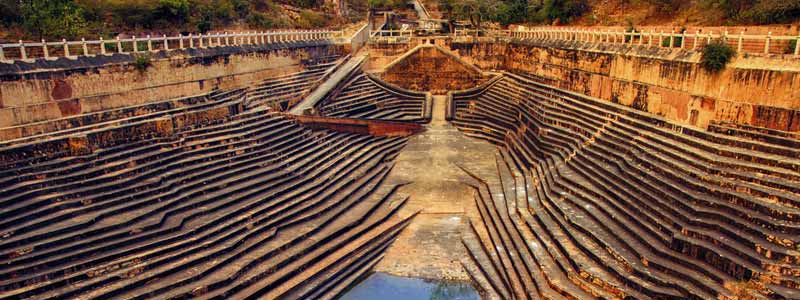
Nahargarh Fort
Nahargarh Fort, located on the rugged Aravalli hills overlooking the Pink City of Jaipur, is one of the most iconic historical landmarks in the region. Built in 1734 by Maharaja Sawai Jai Singh II, the founder of Jaipur, Nahargarh Fort served as a defensive bastion for the city.
The fort’s name, Nahargarh, translates to “abode of tigers” in English, and legend has it that it was named after Nahar Singh Bhomia, a Rathore prince whose spirit haunted the area during the fort’s construction, causing disruptions. To appease his spirit and ensure the fort’s completion, the Maharaja dedicated the fort to him, hence the name, excursion from jaipur.
Nahargarh Fort boasts impressive architectural features, including sturdy walls, bastions, and intricately designed gates. The fort’s design reflects a blend of Indian and European architectural styles, showcasing the grandeur and sophistication of the Rajput era.
Aside from its defensive purposes, Nahargarh Fort also served as a retreat for the royals, offering panoramic views of the Jaipur cityscape below. The fort’s serene ambiance and stunning vistas continue to attract tourists and locals alike, especially during sunrise and sunset, when the sky is painted with hues of orange and pink.
Today, Nahargarh Fort is a popular tourist destination, offering visitors a glimpse into Jaipur’s rich history, architectural marvels, and breathtaking natural beauty. It stands as a testament to the ingenuity and craftsmanship of the bygone era, inviting visitors to explore its corridors, courtyards, and royal quarters while soaking in the majestic views it affords.
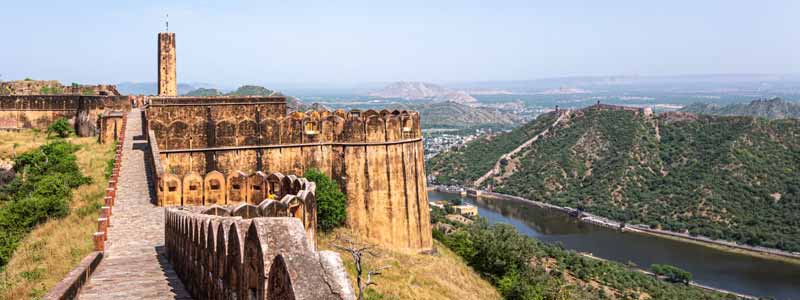
Jaigarh Fort
Jaigarh Fort, located on the Cheel ka Teela (Hill of Eagles) overlooking Jaipur city in Rajasthan, India, is an imposing structure that forms a part of the trio of forts along with Amber Fort and Nahargarh Fort. Built by Maharaja Jai Singh II in 1726, Jaigarh Fort was primarily constructed as a military fortification and served as a stronghold for the defense of Amber and Jaipur.
The fort is renowned for its massive walls, bastions, and watchtowers, which were designed to withstand enemy attacks. One of its most famous features is the Jaivana Cannon, which is believed to be the largest cannon on wheels in the world. This cannon, along with other military structures within the fort, underscores its strategic importance in defending the region.
Apart from its military significance, Jaigarh Fort also houses several palaces, gardens, and reservoirs. The fort’s architecture reflects a blend of Rajput and Mughal styles, characterized by intricately designed gates, courtyards, and residential quarters.
Visitors to Jaigarh Fort can explore its extensive complex, including the armory, museum, and panoramic viewpoints offering breathtaking vistas of the surrounding landscape, including the picturesque Amer town and the Maota Lake. The fort’s historical significance, architectural grandeur, and scenic beauty make it a must-visit destination for tourists exploring the heritage of Jaipur.
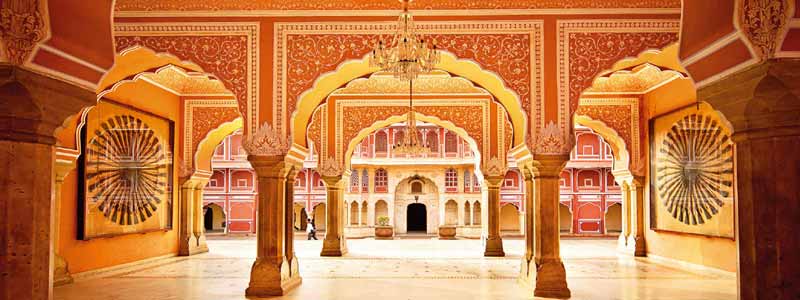
City Palace
The City Palace in Jaipur is a magnificent architectural marvel that serves as a symbol of the city’s royal heritage. It was built by Maharaja Sawai Jai Singh II, the founder of Jaipur, in the 18th century. Located in the heart of the Pink City, the palace complex comprises a series of courtyards, gardens, and buildings, each showcasing exquisite Rajput and Mughal architectural styles.
The City Palace is a blend of Rajput, Mughal, and European influences, reflecting the diverse cultural heritage of Jaipur. The complex houses several palaces, including the Chandra Mahal and the Mubarak Mahal, which now serve as museums showcasing an impressive collection of royal artifacts, including costumes, weapons, paintings, and manuscripts.
One of the most striking features of the City Palace is its intricate facade adorned with beautiful frescoes, marble work, and carved pillars. The palace’s interior is equally captivating, with intricately decorated chambers, halls, and galleries that offer a glimpse into the opulent lifestyle of the erstwhile royal family of Jaipur.
Visitors to the City Palace can explore its various attractions, including the Diwan-i-Khas (Hall of Private Audience), Diwan-i-Aam (Hall of Public Audience), and the Pritam Niwas Chowk, which is adorned with stunning frescoes depicting the four seasons. The palace also offers panoramic views of the city from its elevated vantage points.
Overall, the City Palace in Jaipur is not only a remarkable architectural gem but also a repository of history and culture, providing visitors with a fascinating insight into the royal heritage of Rajasthan.
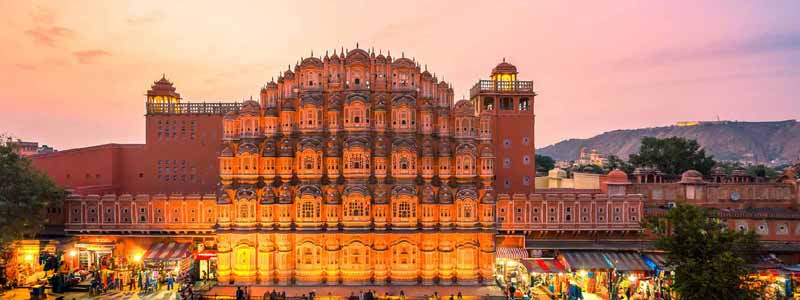
Hawa Mahal
Hawa Mahal, also known as the “Palace of Winds,” is one of the most iconic landmarks in Jaipur, Rajasthan, India. Built in 1799 by Maharaja Sawai Pratap Singh, this stunning red and pink sandstone palace is renowned for its unique façade featuring intricate latticework windows (jharokhas) and balconies.
The five-story palace was designed by Lal Chand Usta in the form of the crown of Lord Krishna, and its 953 small windows were constructed to allow the royal ladies to observe the daily life and festivals of the city while remaining unseen from the outside. This design feature served both functional and aesthetic purposes, providing ventilation and allowing cool breezes to pass through the palace during the hot summers of Rajasthan.
Hawa Mahal’s façade, resembling the honeycomb of a beehive, is an architectural marvel that reflects the Rajputana style with its delicate screens, domes, and spires. The palace’s intricate lattice work also showcases the skilled craftsmanship of the artisans of that era.
While the exterior of Hawa Mahal is its most recognizable feature, the interior of the palace is relatively simple. It consists of small chambers and passages that were once used by the royal women for leisure activities and relaxation.
Today, Hawa Mahal stands as a symbol of Jaipur’s rich cultural heritage and architectural grandeur, attracting tourists from around the world who come to admire its unique design and learn about its historical significance within the city’s royal legacy.
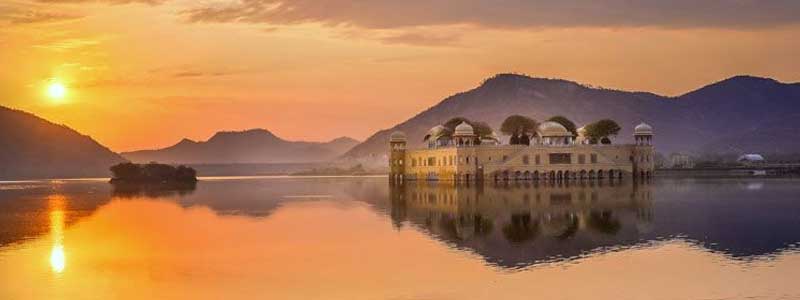
Jal Mahal
Jal Mahal, translating to “Water Palace,” is a stunning architectural marvel situated in the middle of the Man Sagar Lake in Jaipur, Rajasthan. This picturesque palace exemplifies Rajputana architecture and is renowned for its unique location amidst the serene waters of the lake.
Built in the 18th century by Maharaja Madho Singh I, Jal Mahal served as a royal summer retreat and hunting lodge for the rulers of Jaipur. The palace is a five-story structure, with four floors submerged under water when the lake is full, leaving only the top floor visible. Its sandstone walls, intricate detailing, and ornate architecture reflect a perfect blend of Mughal and Rajput styles.
The palace’s strategic location amidst the lake not only enhances its visual appeal but also provides a tranquil ambiance, making it a popular tourist destination. Visitors can admire the beauty of Jal Mahal from afar or take a boat ride on Man Sagar Lake to get a closer view of this architectural gem.
Over the years, Jal Mahal has undergone restoration efforts to preserve its historical significance and structural integrity. Today, it stands as a symbol of Jaipur’s rich cultural heritage and architectural prowess, attracting tourists from around the world who are captivated by its beauty and historical allure.
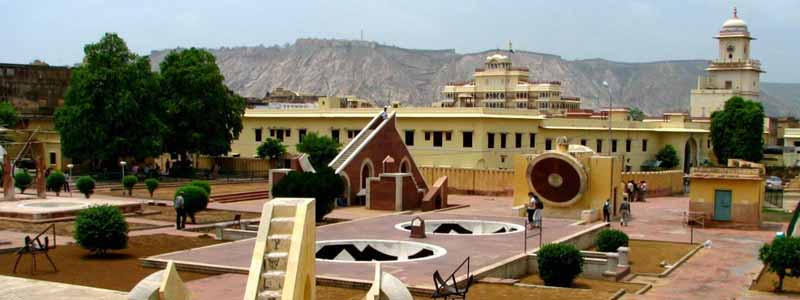
Jantar Mantar
Jantar Mantar in Jaipur is an astronomical observatory and UNESCO World Heritage Site located in the heart of the city. It was built by Maharaja Jai Singh II in the early 18th century and is one of the five Jantar Mantar observatories in India, with others located in Delhi, Varanasi, Ujjain, and Mathura.
This observatory is a remarkable example of ancient Indian astronomical knowledge and architecture. It consists of a collection of architectural astronomical instruments, including large masonry instruments designed for precise measurements of time, tracking celestial bodies, and monitoring astronomical phenomena.
The most notable instruments at Jantar Mantar Jaipur include the Samrat Yantra (the world’s largest sundial), the Jai Prakash Yantra (a hemispherical sundial), the Ram Yantra (a cylindrical structure used for measuring altitude and azimuth), and the Misra Yantra (a combination of various instruments used for multiple astronomical measurements).
Visitors to Jantar Mantar can explore the various instruments and learn about their significance in ancient Indian astronomy. The site offers a unique opportunity to delve into the scientific and cultural heritage of India, showcasing the ingenuity and precision of astronomical observations centuries ago. Today, Jantar Mantar continues to attract tourists, historians, and astronomy enthusiasts from around the world, offering a fascinating glimpse into India’s scientific legacy.
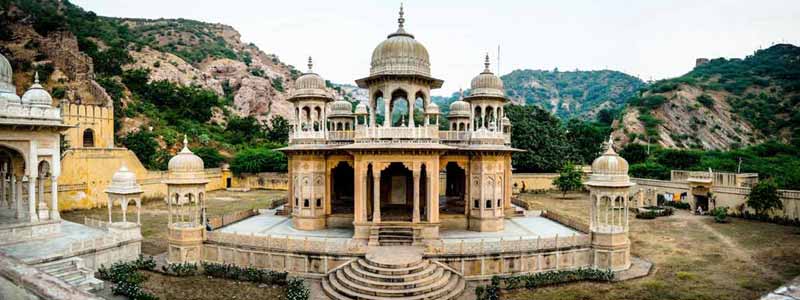
Gatore Ki Chhatriyan
“Gatore Ki Chhatriyan” refers to a group of cenotaphs (chhatris) located in Jaipur, Rajasthan, India. These cenotaphs are dedicated to the royal family members of Jaipur and are situated at Gaitore, which is about 15 kilometers from the city center.
The Gatore Ki Chhatriyan complex is known for its intricate architectural design, which is typical of Rajputana style. The cenotaphs are adorned with beautifully carved pillars, domes, and delicate lattice work, showcasing the skilled craftsmanship of the artisans of that era.
Each cenotaph is dedicated to a specific member of the royal family, including kings, queens, and other prominent figures. The most notable cenotaph in the complex is that of Maharaja Sawai Jai Singh II, the founder of Jaipur, which is the largest and most elaborate.
Gatore Ki Chhatriyan is not only a historical site but also a place of reverence where visitors can pay homage to the illustrious rulers of Jaipur. The serene surroundings and the architectural splendor of the cenotaphs make it a popular tourist attraction for those interested in exploring Jaipur’s rich cultural heritage.
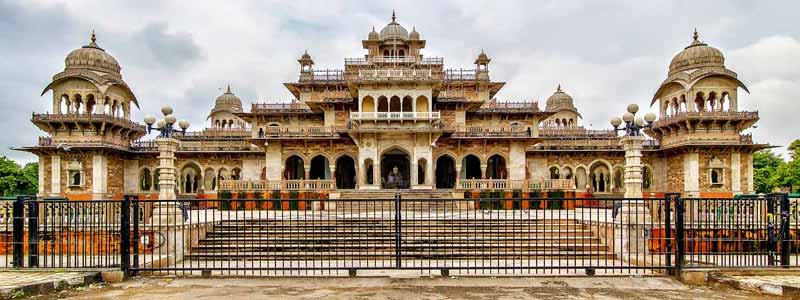
Albert Hall Museum
The Albert Hall Museum, located in Jaipur, Rajasthan, is a magnificent example of Indo-Saracenic architecture. It was designed by Sir Samuel Swinton Jacob and opened to the public in 1887 during the rule of Maharaja Sawai Madho Singh II. The museum was named after Prince Albert, the consort of Queen Victoria, to honor his visit to Jaipur.
The museum is housed in a grand building with elaborate domes, arches, and towers, constructed using sandstone and marble. It was initially intended to be a town hall, but it was later repurposed as a museum to showcase the rich cultural heritage of Rajasthan.
The Albert Hall Museum is home to a vast collection of artifacts including paintings, sculptures, carpets, metalwork, pottery, and textiles. The museum’s exhibits provide a comprehensive insight into the history, art, and culture of Rajasthan, spanning from ancient times to the present day.
One of the highlights of the museum is the Egyptian mummy, acquired from Egypt, which is a significant attraction for visitors. Additionally, the museum’s collection of miniature paintings, arms and armor, and traditional Rajasthani attire offers a glimpse into the artistic and cultural traditions of the region.
The Albert Hall Museum serves as a cultural hub in Jaipur, hosting various exhibitions, workshops, and cultural events throughout the year. It is a must-visit destination for history enthusiasts, art lovers, and anyone interested in exploring the vibrant heritage of Rajasthan.
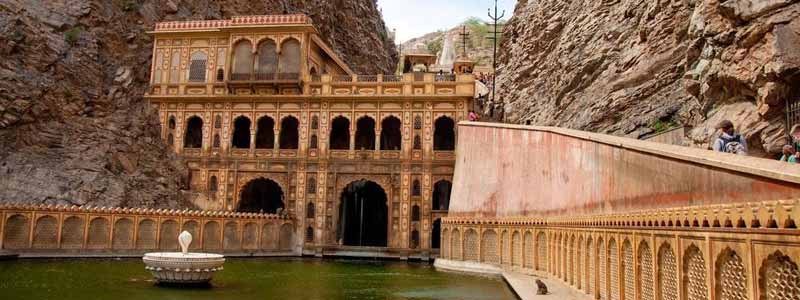
Galtaji Temple
Galtaji Temple, also known as the Monkey Temple, is a significant Hindu pilgrimage site located around 10 kilometers from Jaipur, Rajasthan, India. Nestled amidst the serene surroundings of the Aravalli Hills, this temple complex is renowned for its natural springs, holy water tanks, and intricately carved architecture.
The temple complex comprises several pavilions, temples, and water tanks, all of which are surrounded by lush greenery. The main temple, dedicated to Lord Hanuman, is adorned with beautiful paintings and sculptures depicting scenes from Hindu mythology.
One of the most notable features of Galtaji Temple is its series of natural water springs that flow into tanks, collectively known as the ‘Galta Kund’. Pilgrims often bathe in these sacred waters, believing in their purifying properties. The water is also believed to have therapeutic qualities, attracting visitors seeking relief from various ailments.
Another distinctive aspect of Galtaji Temple is the presence of numerous monkeys that inhabit the area, giving rise to its popular nickname, the Monkey Temple. These monkeys are considered sacred and are an integral part of the temple’s ecosystem.
Galtaji Temple holds religious significance for devotees, particularly during festivals like Makar Sankranti and Kartik Purnima, when large numbers of pilgrims gather here to offer prayers and seek blessings.
Beyond its religious importance, Galtaji Temple also offers a tranquil escape from the bustling city life of Jaipur, making it a popular destination for both spiritual seekers and tourists alike. The temple’s picturesque setting, coupled with its rich cultural and historical significance, makes it a must-visit attraction for anyone exploring the vibrant city of Jaipur.
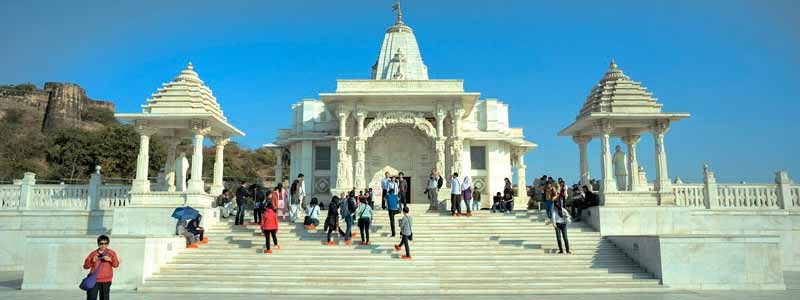
Birla Temple
The Birla Temple in Jaipur, also known as the Laxmi Narayan Temple, is a prominent Hindu temple dedicated to Lord Vishnu and Goddess Laxmi. It is situated at the base of Moti Dungari Hill in Jaipur, Rajasthan, and is one of the most visited religious sites in the city.
This temple was built by the Birla family, one of India’s most influential industrialist families, in 1988. The temple is constructed using white marble, which gives it a striking appearance against the backdrop of the surrounding hills. The intricate carvings and sculptures on the walls and pillars of the temple are noteworthy, depicting various mythological themes and figures.
The main deity of the temple is Lord Vishnu, along with Goddess Laxmi, his consort. The temple complex also houses idols of other Hindu gods and goddesses, including Lord Shiva, Lord Ganesha, and Goddess Saraswati.
Apart from its religious significance, the Birla Temple is renowned for its serene ambiance and architectural splendor. Visitors flock to the temple not only for worship but also to admire its beauty and tranquility. The temple’s location at the foothills of Moti Dungari adds to its charm, offering visitors a peaceful retreat away from the hustle and bustle of the city.
The Birla Temple in Jaipur stands as a symbol of devotion, architectural excellence, and the cultural heritage of Rajasthan, attracting tourists and devotees alike from across the globe.
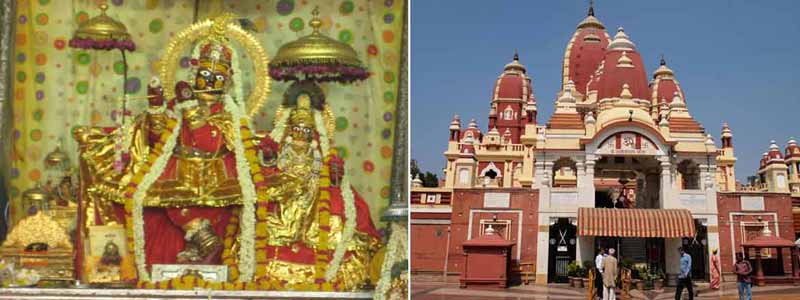
Govind Dev Ji Temple
The Govind Dev Ji Temple is a prominent Hindu temple located in the Pink City of Jaipur, Rajasthan, India. Dedicated to Lord Krishna, it is one of the most visited and revered temples in the city, attracting devotees from far and wide.
The temple was constructed in the 18th century by Maharaja Sawai Pratap Singh, the grandson of Maharaja Sawai Jai Singh II, the founder of Jaipur. The deity worshipped in the temple, Govind Dev Ji, is believed to be an incarnation of Lord Krishna. According to Hindu mythology, the idol of Govind Dev Ji was brought from Vrindavan to Jaipur to protect it from destruction during the reign of Emperor Aurangzeb.
The architecture of the temple follows the traditional Rajasthani style, with intricately carved marble walls, pillars, and domes. The sanctum sanctorum houses the idol of Govind Dev Ji, which is adorned with elaborate decorations and colorful attire, especially during festivals and special occasions.
The temple is not only a place of worship but also a center of cultural and spiritual activities. Daily rituals, prayers, and bhajans (devotional songs) are performed with great reverence. The atmosphere around the temple is vibrant, especially during festivals like Janmashtami (the birth anniversary of Lord Krishna) and Holi, when devotees throng the temple to seek the blessings of Govind Dev Ji.
Visitors to Jaipur often include a visit to the Govind Dev Ji Temple in their itinerary to experience the spiritual ambiance and witness the devotion of the devotees towards Lord Krishna.
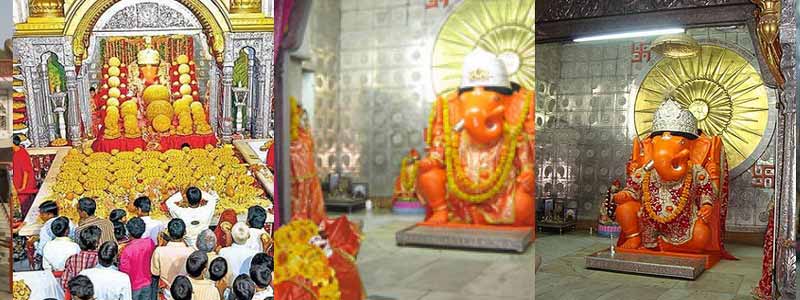
Moti Dungri Ganesh Ji Temple
The Moti Dungri Ganesh Ji Temple is a renowned Hindu temple located in Jaipur, Rajasthan, India. Dedicated to Lord Ganesh, the elephant-headed deity, this temple holds significant religious importance for devotees, especially those in Jaipur and surrounding areas.
The temple is situated atop a small hill called Moti Dungri, which translates to “Hill of Pearls” in English. Its name is derived from the shape of the hill, which resembles a pearl drop. The temple complex also includes shrines dedicated to other Hindu deities, but Lord Ganesh is the primary deity worshipped here.
The architecture of the temple is notable for its distinctive Rajasthani style, characterized by intricate carvings, colorful frescoes, and domed roofs. The temple’s interior is adorned with beautiful paintings and decorations, creating a serene and spiritual ambiance for worshippers and visitors alike.
Devotees flock to the Moti Dungri Ganesh Ji Temple throughout the year, especially on Wednesdays (considered auspicious for Lord Ganesh) and during festivals dedicated to Lord Ganesh, such as Ganesh Chaturthi. It is believed that paying homage to Lord Ganesh at this temple fulfills wishes and brings prosperity and good fortune.
The temple’s location in the heart of Jaipur makes it easily accessible for both locals and tourists, who often visit to seek blessings or simply admire its architectural beauty and spiritual atmosphere. The Moti Dungri Ganesh Ji Temple is not only a religious site but also a cultural landmark that adds to the charm of Jaipur’s vibrant heritage.

